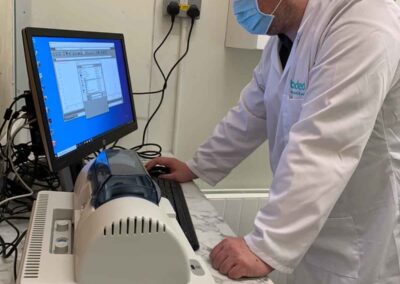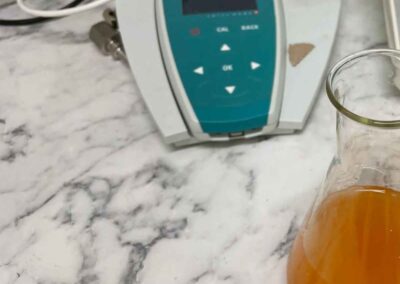The importance & benefits of in-house testing analysis

Whitepaper, by Benjamin France
The Perfect Blend..
Most industries strive for the same common goal – a reduction in costs to increase profitability. One of the ways blended contributes to this for its clients is by offering in-house testing as a service. Technical Quality manager, Ben France, provides insights as to why this is a unique benefit but also very necessary.
“Testing is an important part of a regular maintenance programme, not only can it protect your system, but also carries serious cost saving benefits.”
How Pure is your Refrigerant?
As standard, we verify the glycol percentage on all shipments prior to leaving the site. We also offer a suite of tests to our customers the purpose of this tests is to allow prevention and protection from issues as early as possible and to eliminate the need of a costly shutdown if any problem escalated to a system failure. We also offer testing on ammonia to detect purity and to determine the quantity and type of contaminants, using advanced spectroscopic equipment.
Maintaining & testing glycol based heat transfer fluids
HVAC systems experience changes such as leaks and corrosion within their piping components that can ultimately affect the heat transfer fluid used within them. Observing these changes can significantly increase the effectiveness and longevity of the fluids.
A benefit of in-house laboratory testing at Blended is that pre-emptive actions can be taken before the point of costly system failure.
Our testing includes:
pH levels check
A common route of glycol decay is oxidation, this route causes the formation of acidic chemicals which are corrosive. Under normal circumstances corrosion inhibitors will prevent corrosion from small amounts of acidic compounds.
Many corrosion inhibitors are most effective at basic pH levels and if the formation of these acidic compounds lowers the pH it can reduce the effectiveness of the corrosion inhibitor or in some cases stop it working entirely.
Measurement of the glycol pH allows the monitoring of the situation so preventative action can be taken if needed.
Determination of iron content
If corrosion is occurring inside your system, then this can be accurately monitored via the iron content of the glycol. Most systems are built with steel and if the metal begins to corrode this can be readily detected by increasing iron content in the glycol mixture.
Our spectroscopic method allows for very accurate determination of the iron content in samples.
Review of conductivity
This measurement allows for determination for dissolved salts in the glycol mixture.
These dissolved solids promote corrosion and can indicate that incorrect water is being used for the loading or top up of the system.
Refractometry
This provides an accurate measurement of glycol within the system. With this information it should be possible to determine if a leak has formed on your system somewhere. As water is used to top up the system as per usual (due to water loss) the glycol content will decrease. It is key to maintain glycol levels to keep the frost protection for your system.
Turbidity assessment
This is a measure of how cloudy the glycol is. Most problems that can occur in your system be it corrosion or otherwise will cause the glycol mixture to go cloudy.
Turbidity measurements allow you to measure this and determine if your glycol is becoming contaminated with suspended solids.
Ammonia presence testing
Using our advanced spectroscopic equipment, it is possible to determine if the glycol has been contaminated with ammonia.
This would be indicative of cross contamination between primary and secondary refrigerant.
Simple, yet highly effective procedures
Each of these tests individually shows part of the picture of the glycol solution running in your system but combined they allow a comprehensive understanding. This knowledge helps our customers understand problems in their glycol systems allowing for effective preventative actions to be taken. This increases the efficiencies of their systems and reduces downtime all of which contributes to lower running costs.
Deep dive in Glycol Testing
We have already had some success in testing secondary refrigerant solutions for our customers. In one case we were contacted about a system our customer had recently taken ownership of and they needed to understand the state of the system and the best way to start it up.
It was clear there was a problem as the sample of existing fluid was orange in colour immediately indicating that the system was rusting to some extent. Our iron test was able to quantify the levels of iron in the solution and it went above our standard grading scale which indicated a severe problem. If we had stopped here, we would have recommended an in-system flush with filtration and a top up of corrosion inhibitor.
In reality we did a full suite of tests and found the glycol concentration was very low with refractometry, the conductivity was very high, and the pH was extremely low. This all pointed to the solution being completely compromised and as a result our customer completely emptied the system and was able to flush it with our Serviceblend PRE before starting it up with a fresh glycol solution. If our customer did not have access to testing capability it is possible, they would have assumed it was a rust problem and only topped up the corrosion inhibitor. With such a low pH this would likely have had no effect and the system would have continued to deteriorate leading to a costly shut down.
Ammonia testing, rare, but necessary
When in use as a refrigerant the water content of ammonia is well recognised as an issue, the more water contamination that is present in the system the higher the energy costs will be to achieve the same refrigeration temperatures.
Given the volatility in the energy market seen over the past 12 months running a refrigeration plant as efficiently as possible has become even more important. While the negative impact of contaminants in an ammonia refrigeration system is widely understood it is not yet standard practice for the refrigeration industry to regularly test the ammonia in their system. When the water testing is coupled with gravimetric purity and oil analysis it is possible to gain a well-rounded picture of the state of the ammonia refrigerant in the system.
By implementing a regular testing regime, it will be possible to verify the quality of the ammonia and gain some idea of the level and identity of contaminants present and track the changes over time. This will allow a customer to understand what kind of contaminants are in their system and help to understand where they may be coming. When this data is coupled with energy consumption data it will become possible for our customers to calculate the point it would make more sense economically to get a fresh load of ammonia as the energy savings outweighs the cost of fresh refrigerant.
Examples in practice
In the testing we have performed in our lab beyond providing information to customers on the quality of their ammonia we have been able to pick up signs of other problems. In a recent examination a blue residue was found inside the ammonia, after discussion with the customer it became apparent there were 2 potential causes:
• This system used a blue glycol solution as secondary refrigerant so there was a concern that the heat exchanger between primary and secondary refrigerant may be failing allowing the transfer of primary and secondary refrigerants across the heat exchanger.
• Ammonia reacts with copper forming cuprammonium ions which have a blue colour. If brass fittings had been used on the plant the ammonia would rapidly corrode them producing the cuprammonium ions. It was likely over time the ammonia would corrode the brass fitting sufficiently that there would be a loss of containment.
Both options presented problems to our customer, so this prompted us to perform additional analysis and we were able to identify the blue colour was a result of cuprammonium ions. We then informed the customer that brass had been used on their plant and they were able to act to rectify this problem.
Laboratory testing, endless benefits
“There is a great deal of value in laboratory testing of ammonia that is rarely accessed due to the logistical and safety challenges working with anhydrous ammonia poses.
At Blended we have bespoke sampling and testing equipment that allows us to perform gravimetric purity, water content and oil content on a sample of anhydrous ammonia safely.”
These lab tests are giving our customers the information they need to run their plants as efficiently as possible while enabling them to understand where problems may be occurring and allow preventative maintenance which reduces the chance of unexpected shutdowns. Blended strongly recommend that testing of the ammonia on a 6 monthly cycle be included as part of the standard maintenance cycle for an ammonia refrigeration system. Glycol solutions should also be tested regularly; every 12 months for refrigeration duty and every 6 months for heating duty due to the enhanced corrosion risks present at elevated temperatures.
Collaborators:
Benjamin France – Technical & Quality manager
Emma King – Marketing manager
More from Blended
Industries that benefit from Aquamonia 245
Aquamonia 245 is the latest addition to Blended Products’ industrial chemical range – a...
New! Molybdate Test Kits
We’re excited to introduce the latest addition to our testing and monitoring range – Blended...
Non-Hazardous – When is it true?
When can a chemical truly be called non-hazardous? The term non-hazardous carries a lot of weight...













